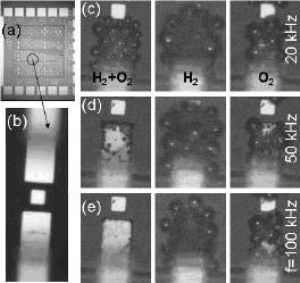Physicists at the MESA+ Institute for Nanotechnology of the University of Twente have for the first time illustrated the spontaneous combustion in nanobubbles containing oxygen and hydrogen gases, but they did not observe such phenomenon in larger bubbles.
 Formation of bubbles at the electrodes during electrolysis (can be seen in a and b). Situations c, d, and e show the formation of both hydrogen and oxygen on the left, hydrogen alone in the middle and oxygen alone on the right. Situation e shows combustion taking place on the left. No bubbles can be seen on the electrodes.
Formation of bubbles at the electrodes during electrolysis (can be seen in a and b). Situations c, d, and e show the formation of both hydrogen and oxygen on the left, hydrogen alone in the middle and oxygen alone on the right. Situation e shows combustion taking place on the left. No bubbles can be seen on the electrodes.
The researchers have reported their findings in Physical Review E. They plan to employ the phenomenon to develop an ultra-small ultrasonic loudspeaker. It is already apparent that a fierce reaction has occurred on the electrodes from the damage suffered by them. These electrodes are utilized to generate oxygen and hydrogen gases in an ultra-compact reaction chamber by electrolysis. By constantly alternating the minus and plus poles, nanobubbles containing oxygen and hydrogen gases are generated.
The size of the bubbles varies inversely with the rate at which the poles are swapped. Combustion occurs only in bubbles with sizes below 150 nm and nothing is occurs in larger bubbles. Scientist Vitaly Svetovoy discovered this phenomenon when he was developing an actuator for quickly building pressure. Such actuators can be utilized in loudspeakers for frequencies in the ultrasonic range inaudible by the human ear. Existing mechanical techniques cannot produce such a kind of ultra-compact loudspeaker and obtain a deflection of m/s on this range.
Svetovoy believes that bubbles can be used for building up pressure. The issue was that the bubbles can be produced rapidly but they did not vanish quickly enough. This issue can be solved by the combustion reaction but it creates other issues such as the electrode damage.